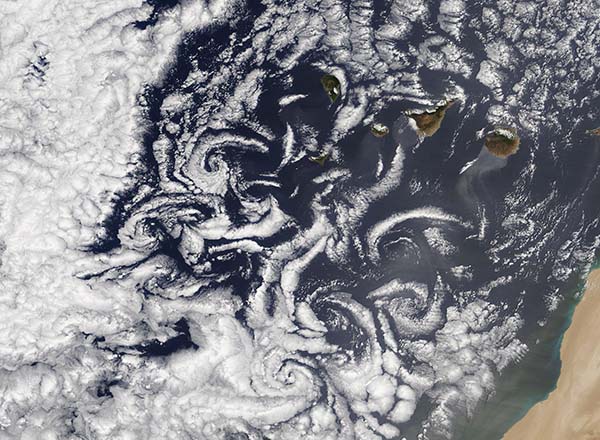Images
April 15, 2022 - Sand and Cloud Swirls off the Canary Islands
Tweet
In mid-April 2022, strong winds stirred up Saharan dust and carved delicate swirling patterns in the clouds on the lee side of the Canary Islands. The Moderate Resolution Imaging Spectroradiometer (MODIS) on board NASA’s Terra satellite captured a stunning true-color image of the cloud-and-dust event on April 14.
The Canary Islands, an archipelago of islands and islets, are the southernmost of the autonomous communities of Spain. Although they sit only about 62 miles (100 km) west of the African coast, they are politically part of Europe. The islands have volcanic origins, and thus are rugged with high-reaching and steep peaks. The El Teide volcano, located on the island of Tenerife, soars to about 3,715 meters (12,188 feet) above sea level and is considered the highest peak in Spain. The steep topography of the Canary Islands creates a significant impediment to the frequent and strong winds that pulse off the northwestern coast of the African continent.
Both the oceans and atmosphere are fluids and are in constant motion. While it is easier to see currents in the ocean, currents also flow in the air but are generally invisible to our view. Only when cloud or particulates (dust) are also present in the atmosphere does the motion become visible. When we look at the motion of an ocean tidal current as it slams against a solid, immobile object such as a large boulder, we see that on side of the boulder opposite the current swirling eddies are formed as the water rushes around the boulder. Similarly, as strong winds strike the high, immobile faces of the mountainous Canary Islands, eddies are created on the lee side (side opposite the motion of the wind). Normally invisible, when clouds are present on the lee side of the islands, the turbulence of the eddies is visible in the clouds.
The type of eddies seen written in the marine stratocumulus cloud layer behind the Canary Islands on this day are a special type known as von Kármán vortices. The physical processes that create this particular pattern was first described by Theodore von Kármán, a Hungarian-American physicist. This type of unique flow occurs as winds are diverted around tall mountains, creating a disturbed flow of air that propagates downstream in the form of vortices that alternate their direction of rotation. On this day, a set of von Kármán vortices can be seen behind Tenerife Island (west) and Grand Canary Island. Camel-colored dust, carried by the same winds that created the vortices, is also visible both off the coast of Africa and caught in the flow of air behind three islands as well as in the clouds behind Grand Canary Island.
Image Facts
Satellite:
Terra
Date Acquired: 4/14/2022
Resolutions:
1km (194.2 KB), 500m (424.2 KB), 250m (1.4 MB)
Bands Used: 1,4,3
Image Credit:
MODIS Land Rapid Response Team, NASA GSFC
Tweet
In mid-April 2022, strong winds stirred up Saharan dust and carved delicate swirling patterns in the clouds on the lee side of the Canary Islands. The Moderate Resolution Imaging Spectroradiometer (MODIS) on board NASA’s Terra satellite captured a stunning true-color image of the cloud-and-dust event on April 14.
The Canary Islands, an archipelago of islands and islets, are the southernmost of the autonomous communities of Spain. Although they sit only about 62 miles (100 km) west of the African coast, they are politically part of Europe. The islands have volcanic origins, and thus are rugged with high-reaching and steep peaks. The El Teide volcano, located on the island of Tenerife, soars to about 3,715 meters (12,188 feet) above sea level and is considered the highest peak in Spain. The steep topography of the Canary Islands creates a significant impediment to the frequent and strong winds that pulse off the northwestern coast of the African continent.
Both the oceans and atmosphere are fluids and are in constant motion. While it is easier to see currents in the ocean, currents also flow in the air but are generally invisible to our view. Only when cloud or particulates (dust) are also present in the atmosphere does the motion become visible. When we look at the motion of an ocean tidal current as it slams against a solid, immobile object such as a large boulder, we see that on side of the boulder opposite the current swirling eddies are formed as the water rushes around the boulder. Similarly, as strong winds strike the high, immobile faces of the mountainous Canary Islands, eddies are created on the lee side (side opposite the motion of the wind). Normally invisible, when clouds are present on the lee side of the islands, the turbulence of the eddies is visible in the clouds.
The type of eddies seen written in the marine stratocumulus cloud layer behind the Canary Islands on this day are a special type known as von Kármán vortices. The physical processes that create this particular pattern was first described by Theodore von Kármán, a Hungarian-American physicist. This type of unique flow occurs as winds are diverted around tall mountains, creating a disturbed flow of air that propagates downstream in the form of vortices that alternate their direction of rotation. On this day, a set of von Kármán vortices can be seen behind Tenerife Island (west) and Grand Canary Island. Camel-colored dust, carried by the same winds that created the vortices, is also visible both off the coast of Africa and caught in the flow of air behind three islands as well as in the clouds behind Grand Canary Island.
Image Facts
Satellite:
Terra
Date Acquired: 4/14/2022
Resolutions:
1km (194.2 KB), 500m (424.2 KB), 250m (1.4 MB)
Bands Used: 1,4,3
Image Credit:
MODIS Land Rapid Response Team, NASA GSFC




